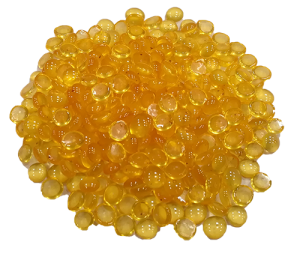NOVOLAK RESINS

Novolaks are synthetic thermoplastic phenol-formaldehyde resins, produced industrially as an acid-catalysed condensation polymers.
Novolak belongs to the group of linear, thermoplastic phenolic resins. On industrial scale those polymers are produced using an excess of phenol in an acid medium, by which premature curing may be avoided. After dehydratation and thermal processing, product in form of light yellow to light brown flakes or tears is obtained.
Novolak GD
|
Parameters |
Unit |
Value |
Test method |
|
Appearance |
Flakes or tears in light yellow to light brown colour |
||
|
Melting point |
°C |
110-116 |
PN-EN 1427:2009 |
|
Free phenol content |
% |
max. 0,5 |
PL-W-015 |
|
Ash content1) |
% |
max. 0,02 |
PN-EN ISO 3451-1:2010 |
Novolak S
|
Parameters |
Unit |
Value |
Test method |
|
Appearance |
Flakes or tears in light yellow to light brown colour |
||
|
Melting pount |
°C |
94-102 |
PN-EN 1427:2009 |
|
Free phenol content |
% |
max. 0,3 |
PL-W-015* |
|
Ash content1) |
% |
max. 0,02 |
PN-EN ISO 3451-1:2010 |
1) method A, 5 g sample, 850°C
* – Allowed to make the determination in accordance with EN ISO 8974:2004 by other chromatographic conditions and the internal standards and the other columns of the characteristics (length, diameter, stationary phase) to ensure good separation of volatile compounds (phenol, an internal standard, solvent).
APPLICATION
The most important applications for high-quality novolak resin in the form of tears or flakes are the rubber and tire industries. In combination with a cross-linking agent, the so-called hardener (e.g. aldehydes, urotropin) and heating, reinforcing resins are created, the presence of which in the tire production process causes the formation of a resit network. The latter penetrates into the vulcanized rubber, resulting in higher viscosity of the compound and finally in increase of the hardness of rubber, better resistance to abrasion and friction, higher tensile strength as well the modulus of elasticity. Cured novolak resins also show good resistance to solvents, oxidation processes and heat.
Considerable amounts of novolak resins are used in the production of molding compositions, filled mainly with wood flour or celulose, which are then pressed in the processing of various types of products called bakelite. They are also applied as a binder in the production of refractory materials as well as carpets, mats, insulations and in the synthesis of epoxy resins. Ethoxylated alkyl derivatives of novolak resins due to their surface activity properties can be exploited as deemulsifiers, that have the ability to effectively separate oil from a mixture with brine.
PACKAGING:
The product is packed in sacks or big bags. It is also possible to use another form of packaging after consultation with the Customer.
COUNTRY OF ORIGIN:
Poland
Full technical documentation including technical specifications, safety data sheets, ISO certificates, REACH certificates and other regarding the product are available upon request. Please contact us.